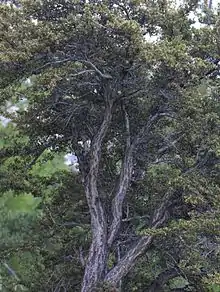Cercocarpus ledifolius
Cercocarpus ledifolius is a North American species of mountain mahogany known by the common name curl-leaf mountain mahogany. It widespread across much of the Western United States as well as Baja California in Mexico.[2][3] It can be found at elevations ranging from 600 to 3,000 m (2,000 to 9,800 ft) elevation, with the preferred altitude varying depending on the region. It prefers shallow, well-drained soils with a sandy or grainy consistency, and is generally found in areas which receive low annual precipitation (15-26 cm).[4] This makes it common on low mountains and slopes,[5][3] where it grows in scattered groves among other drought-resistant species such as Pinyon Pines, Junipers and Sagebrush ecosystems.
| Cercocarpus ledifolius | |
|---|---|
 | |
| Scientific classification | |
| Kingdom: | Plantae |
| Clade: | Tracheophytes |
| Clade: | Angiosperms |
| Clade: | Eudicots |
| Clade: | Rosids |
| Order: | Rosales |
| Family: | Rosaceae |
| Genus: | Cercocarpus |
| Species: | C. ledifolius |
| Binomial name | |
| Cercocarpus ledifolius | |
 | |
| Natural range of Cercocarpus ledifolius | |
| Synonyms[1] | |
| |

Description
Cercocarpus ledifolius is a large, densely branching tree which can reach heights of 11 m (35 ft), although it is not uncommon to find the adult plant as a shrub as short as 1m (3ft). Its leathery, sticky, dark green leaves are up to 4 centimeters (1.6 inches) long and lance-shaped, and the edges may curl under. The flower consists of a small tan tube from which protrudes a long, plumelike style covered in luxuriant tan hairs. The flowers are arranged in inflorescences of up to 3. The fruit is a hairy achene one half to just over one centimeter (0.2-0.4 inches) long.
Age
Cercocarpus ledifolius is slow-growing, sometimes taking up to a century to reach full height. The oldest specimens are thought to be around 1,350 years old, although the primary specimen that yielded this estimate was cut down.[6] This makes it one of the longest lived known flowering plants.
Ecology and uses
The leaves are eaten by deer year-round.[7]
The Gosiute Native Americans used the wood to make their bows.[7] The species has many medicinal uses for various Native American groups, such as the Paiute and Shoshone.
References
- The Plant List, Cercocarpus ledifolius Nutt. ex Torr. & A.Gray
- Biota of North America Program 2014 county distribution map
- Flora of North America, Cercocarpus ledifolius Nuttall in J. Torrey and A. Gray, 1840. Curl-leaf mountain mahogany
- "Cercocarpus ledifolius". www.fs.fed.us. Retrieved 2019-05-23.
- Calflora taxon report, University of California, Cercocarpus ledifolius Nutt. Desert mountainmahogany, curl leaf mountain mahogany
- Schultz, W.; Tueller, P.T.; Tausch, R.J. (1990). "Ecology of curlleaf mahogany in western and central Nevada: community and population structure" (PDF). Journal of Range Management. 43 (1): 13–20. doi:10.2307/3899112. Archived from the original (PDF) on 2010-06-20. Retrieved 2008-10-09.
- Peattie, Donald Culross (1953). A Natural History of Western Trees. New York: Bonanza Books. p. 525.
External links
 Media related to Cercocarpus ledifolius at Wikimedia Commons
Media related to Cercocarpus ledifolius at Wikimedia Commons- Jepson Manual Treatment of Cercocarpus ledifolius
- ledifolius.pdf United States Department of Agriculture IITF description; Cercocarpus ledifolius
- Ethnobotany, University of Michigan
- Cercocarpus ledifolius in the CalPhotos Photo Database, University of California, Berkeley